German West Africa Deutsch-Westafrika | |
|---|---|
| 1884â1915 | |
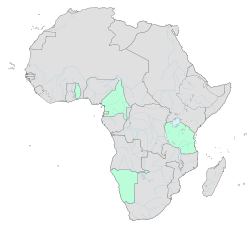 German colonies in Africa in 1913 | |
| Status | German colony |
| Religion |
Christianity Indigenous beliefs |
| Historical era | Scramble for Africa |
⢠Established | 1884 |
| 28 June 1919 | |
| Area | |
| 1912 (Including Togo) | 879,510 km2 (339,580 sq mi) |
| Population | |
⢠1912 (Including Togo) | 5.645.000 |
German West Africa (Deutsch-Westafrika) was an informal designation for the areas in West Africa that were part of the German Colonial Empire between 1884 and 1919. The term was normally used for the territories of Cameroon and Togo. German West Africa was not an administrative unit. However, in trade and in the vernacular the term was sometimes in use.
German interests in West Africa before 1884

German interest in West Africa dated from the 17th and 18th centuries, when the Duchy of Courland and Brandenburg-Prussia established fortifications and trading posts in the region. After 1720 there was no German presence in West Africa until the middle of the 19th century, when German trading companies including C. Woermann, Jantzen & Thormählen, Wölber & Brohm and GL Gaiser became active on the West African coast. [1] [2] German missionaries, such as the North German Missionary Society, were also present from the mid 19th century. [3] [4]
By the early 1880s German interests in West Africa consisted of:
- trading posts in modern Guinea at Kapitaï and Koba operated by Friedrich Colin
- trading posts in modern Togo at Baguida and Little Popo dating from 1857
- trading posts and agreements with rulers of a number of coastal villages in modern Cameroon, including Bimbia, Malimba, Batanga, Kribi. There were German trading posts and agreements in the land of the Duala people, at Akwa-Town, Bell-Town and Dido-Town, which also had similar arrangements with British and other European traders.
The Anglo-French Convention of 1882 led to concerns among Hamburg merchants that their interests would be threatened, and they began to seek the protection of the German Empire for their activities. [5]: 32â34 At the same time as established German commercial interests in West Africa were seeking government and naval support, the broader social movement in favour of colonisation was gaining ground. The German Colonial Society (âDeutscher Kolonialvereinâ) was founded on December 6, 1882, in Frankfurt am Main with Hermann, Prince of Hohenlohe-Langenburg as its first president, and soon had about 15,000 members. [6]
Imperial Commissioner for West Africa
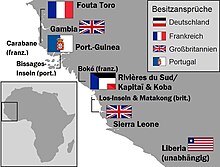
Chancellor Otto von Bismarck asked for views on potential German intervention in West Africa from the senates of Lübeck, Hamburg and Bremen. In response, Woermann submitted to the Chancellor plans for the establishment of a German-West African trade colony in 1883, which Bismarck initially received with some reservations. [7] In December 1883 however the government undertook to take action to protect German traders by sending an Imperial Commissioner for West Africa to enter into formal treaties with local rulers. [8] [5]: 35
In May 1884 Bismarck decided to appoint Gustav Nachtigal as Imperial Commissioner. His mission was to sail right down the Atlantic coast of the continent, to explore and test the existing a German claims in the region, and where possible to establish new ones. [9] Bismarck's plan was to use Nachitigal's treaties to establish German sovereignty over key areas in West Africa, which would then be governed indirectly, with administration undertaken mainly by a commercial company. [10] [5]: 39
In June 1884 Nachtigal reached Sangareya bay and the Los islands. He sent a party ashore to seek treaties with the rulers of Kapitaï and Koba. [11] However, by the time he arrived the local chiefs had already reached agreements with France, and did not want to sign any new treaties. [12] Nachtigal therefore steamed on to the German trading posts on the Bight of Benin. [8]
On 5 July 1884 Nachtigal signed a treaty with Mlapa III, ruler of Togo (a village known today as Togoville) establishing a German protectorate over a stretch of coastal territory. [13] This formed the basis of the future German colony of Togoland. [14] On 14 July 14, 1884, Nachtigal raised the German flag in Bell town and signed treaties placing under German protection the areas which became the colony of Kamerun. [5]: 41 He spent some weeks visiting various ports around the Bight of Biafra before sailing south to Gabon, Angola and South West Africa. He steamed back to Kamerun in December 1884 and the Niger Delta in January 1885. [15] On 29 January 1885 he signed a treaty which brought Mahinland under German protection. [16] After this Nachtigal began his return journey to Germany but succumbed to malaria and died off the coast of Guinea in April. [17]
West African squadron, 1884â85
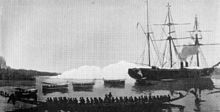
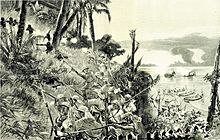
After Nachtigal had completed his mission of establishing German rights in West Africa, there was a need for naval support to reinforce them. On September 30, 1884, Emperor Wilhelm I issued an order establishing a West African squadron under the command of the Chief of the Staff of the Admiralty, Rear Admiral Eduard von Knorr. [18] The squadron was composed of the corvettes SMS Bismarck (flagship), SMS Gneisenau, SMS Ariadne, SMS Olga and the steam tender Adler. The squadron departed for West Africa on October 30. On reaching the Cape Verde Islands, it dispatched the Ariadne to Liberia and the Guinea coast and the Gneisenau was sent to East Africa. On December 18, the Bismarck and the Olga reached the Cameroon River. [19]
Shortly before the squadron arrived, the settlement of chief Manga Ndumbe Bell, who had signed a treaty with Nachtigal, had been burned down and the German flag removed. Admiral Knorr decided on immediate intervention and sent landing parties ashore to destroy the villages of the rebels and arrest their chiefs. Two coastal steamers, the Fan and the Dualla were used as landing craft to bring 307 soldiers ashore at Hickorytown on 20 December. The landing party received word that rioters on the opposite bank had attacked the Jantzen & Thormählen factories and carried off their managers, and they stormed Joss town to try and recover them. The next day the Olga steamed upriver on the rising tide and bombarded the local villages. The landing party returned to their ships on 22 December. The Olga, with Rear Admiral Knorr on board, remained in the area where the anti-German uprising had taken place. Calm was gradually restored; in January 1885 the violence ended and in March the murderer of the factory manager was handed over for execution. [19]
On March 23, 1885, the gunboat SMS Habicht arrived to replace the Olga at its permanent station in the river, allowing the Olga to return home together with the Adler. Meanwhile, the Bismarck cruised up and down the coast, hoisting the German flag in a number of places. Following the arrival of the first Imperial Governor of Kamerun, Julius von Soden on 7 July 1885, the Bismarck received orders to sail for East Africa while the gunboat Cyclop took up its position as the second gunboat on the West Africa station. [18] After pacification of tribal feuds and unrest in the area under German protection, the West African Squadron was dissolved in July 1885.
However, in September 1885 Captain Karl Paschen was commanded to re-form the squadron with SMS Stosch, SMS Prinz Adalbert and SMS Gneisenau, deployed under Rear Admiral Knorr in East Africa, and return to the coast of West Africa. In the event, the multiple demand on Germany's small force of gunboats meant that on reaching Cape Town, the Gneisenau was ordered back to East Africa, leaving only the Prince Adalbert and the Stosch to continue to West Africa before proceeding back to Germany, and the West African squadron was finally dissolved in December 1885. [20] After this the Imperial German Navy established the West African Station, covering the maritime area off the coast of West Africa. Warships were assigned to the ports of the new German colonies. [21]
The West Africa Conference and territorial adjustments
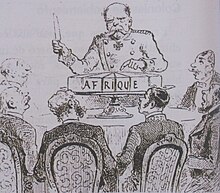
Having staked its claims with Nachtigal and backed them up with naval force by dispatching the West Africa Squadron, Germany needed to secure international recognition of its position in the region. Bismarck believed that the acquisition of colonies, while expensive and of no real economic or military interest, was beneficial in terms of gaining bargaining power with other governments. [22] His foreign policy goal was to secure an international agreement that would place a check on the extensive âinformal empireâ that Britain had built up. With French support, he, therefore, convened a conference in Berlin which would place Germany's acquisitions in Africa on an internationally recognised footing and would establish the rules that all powers would follow in future when making territorial claims in the continent. [23]
The Berlin Conference (known as the âWest Africa Conferenceâ [24] [25] [26] or the âCongo Conferenceâ) convened in November 1884, and remained in session until February 1885. [27] The General Act of the conference made no mention of Togo, Kamerun or any specific territory other than the basin of the Congo. [28] Nevertheless, the conference did confirm the steps required in order for the Powers to recognise each other's territorial claims in West Africa â steps which Nachtigal had followed. Along with a number of claims by other Powers, German claims in West Africa were thus effectively recognised by means of the conference. In parallel with the main conference sessions, discussions were pursued which were intended to avoid possible conflict by tidying up overlapping claims and starting to define borders. [29] [30] Just two months after the Berlin Conference, on 22 April 1885, Germany concluded a treaty with England which established the borders around Mount Cameroon. The following year, on May 6, 1886, another treaty extended the frontier to the east. An agreement with France on December 24, 1885, fixed the Campo River as the southern border of Kamerun.[ citation needed]
As these border agreements proceeded, Germany abandoned certain of its claims in order to consolidate its position in Togoland and Kamerun. Thus on October 24, 1885, Mahinland came under British protection in return for territorial compensation to Germany. [31] On 24 December 1885 Kapitaï and Koba were ceded to France in return for compensation in Togo. [14]
In 1884 an expedition led by Eduard Schulze tried to establish a Germany colony near Nokki on the Congo, but it received no official support. [32] [33] [34] The International African Association recognised the German claim, the borders of which were never defined. However at the Berlin Conference Bismarck ceded German rights in Nokki to Portugal. [35]
Race for the Niger
While the Berlin Conference was largely concerned with the Congo, there was also competition between Germany, France and Britain for rights on the Niger, an important artery for the colonization of the interior. Despite the failure of Gottlieb Leonhard Gaiserâs venture in Mahinland, German traders still wanted duty-free access to the upper Niger. [36] The Benue expedition of Paul Staudinger in 1885/86 sought to establish relations with the Sokoto Caliphate and the Emirate of Gwandu, but this did not lead to occupation or protection. [37] Likewise Friedrich Colinâs attempt to reach the headwaters of the Niger from Guinea came to nothing after Germany agreed to cede Kapitaï and Koba (also known as âColinslandâ) to France.
In 1894/95 an expedition funded by the Togo Committee and led by Hans Gruner attempted to acquire territories for Germany in the central Niger region. Gruner and his companion Ernst von Carnap-Quernheimb travelled the Niger and concluded "treaties of protection" with chiefs of Gwandu and Gurma. [38] However the French and British representatives signed similar agreements with the same chiefs, so they were of no value to Germany. Other German forays towards Niger, by Erich Kling, Gaston Thierry, Ludwig Wolf and Julius von Zech auf Neuhofen were similarly unsuccessful. Ultimately all Germany was able to gain for its efforts in the Niger basin was favourable adjustments to the border between Togoland and French West Africa when the border was settled by agreement in 1897. [39] [40] [41]
West African Syndicate
In October 1884, with Bismarck's support, the syndicate for West Africa was founded, which was intended to take over the internal administration of the West African colonies. However, the companies involved refused to assume this responsibility on their own and instead demanded the establishment of German government administration. [42] Bismarck's idea of indirect rule in the German "protected areas" had thus failed in West Africa. In 1886, the syndicate dissolved. [43]
Administrative relations for the German colonies in West Africa
The German colonial enterprise in West Africa was started by Gustav Nachtigal as Imperial Commissioner for West Africa. He started formally the "Schutzgebiete" (literally: "protectorates") in Kamerun, Togo and South-West Africa. This connection is reflected in the first legal decrees which were jointly done for the posts of the chief officials in these colonies, i.e. governor of Kamerun and the commissioners of Togo and South West Africa [44]
Later a number of decrees were jointly issued for Kamerun and Togo. Togo was ruled as a separate colony by an Imperial Commissioner (from 1893: "Landeshauptmann" [45]) until 1898 who was supervised by a Chief Commissioner ("Oberkomissar") who was at the same time the governor of Kamerun. The first governor of Kamerun, Julius von Soden, was also the Chief Commissioner for Togo. In 1898 the position in Togo was elevated to the rank of governor. [46]
For the courts in charge of Europeans, there was a joint "Appellate Court for the protectorates of Kamerun and Togo" (Kaiserliches Obergericht der Schutzgebiete von Kamerun und Togo). [47]
The designation Deutsch-Westafrika appeared in a few non official publications concerning the two colonies. [48] [49]
A trading company which was active in Kamerun, Togo, Nigeria and Gold Coast used the name "Deutsch-Westafrikanische Handelsgesellschaft" (German West African Trading Company), founded in 1896 [50] and was also involved in the 1904 founding of the "Deutsch-Westafrikanische Bank" (German West African Bank). [51]
Territories
Areas under German rule in West Africa between 1884 and 1919 were the following (excluding German South West Africa): [52]
| Territory | Period | Area (circa) |
Population (circa) |
Current countries |
|---|---|---|---|---|
|
Altkamerun (without the north-east) |
1884â1919 | 488,000 km2 (Excluding "Entenschnabel") |
2,588,000 | |
| Ambasbay/ Victoria [53] | 1887â1919 | ? | 12,000 | |
| Entenschnabel | 1894â1911 | 12,000 km2 | ? | |
| Kapitaï and Koba | 1884â1885 | 2,310 km2 | 35,000 | |
| Mahinland | 1885 | 5,210 km2 | 10,000 | |
|
Neukamerun (Deutsch-Kongo) |
1911â1919 | 295,000 km2 | 2,000,000 | |
| Salaga Area (East) | 1899â1919 | 2,800 km2 | ? | |
| Togo | 1884â1919 | 87,200 km2 (Including the Eastern Salaga Area) |
1,000,000 | |
| Total | 879,510 km2 | 5,645,000 |
See also
References
-
^ Bade, Klaus (2005).
Friedrich Fabri und der Imperialismus in der Bismarckzeit. Revolution â Depression â Expansion (PDF). Osnabrück. p. 347. Retrieved 20 January 2019.
{{ cite book}}: CS1 maint: location missing publisher ( link) - ^ L. H. Gann; Peter Duignan; Victor Witter Turner (1969). Colonialism in Africa 1870-1960. CUP Archive. p. 221. ISBN 978-0-521-08641-7.
- ^ Rainer Alsheimer. Zwischen Sklaverei und christlicher Ethnogenese. Waxmann Verlag. p. 19. ISBN 978-3-8309-6764-4.
- ^ Blackshire-Belay, Carol Aisha (1992). "German Imperialism in Africa: The Distorted Images of Cameroon, Namibia, Tanzania, and Togo". Journal of Black Studies. 23 (2): 235â246. doi: 10.1177/002193479202300207. JSTOR 2784532. S2CID 141534668.
- ^ a b c d H.R. Rudin (1938). Germans in the Cameroons. Yale University Press. p. 38. ISBN 978-5-88159-981-2.
- ^ Auflagenhöhe der Deutsche Kolonialzeitung im Februar 1885 (source: ZDB-ID 214536-4)
- ^ Mommsen, Wolfgang J. (1994). Das Ringen um den nationalen Staat â Die Gründung und der innere Ausbau des deutschen Reiches unter Otto von Bismarck 1850 bis 1890.. Berlin: Propyläen Verlag. p. 514. ISBN 978-3549058176.
- ^ a b Von Koschitzky, Max (1887). Deutsche Colonialgeschichte. Leipzig: Verlag von Paul Frohberg. p. 151. Retrieved 27 January 2019.
- ^ Steven Press (2017-04-10). Rogue Empires: Contracts and Conmen in Europe's Scramble for Africa. Harvard University Press. pp. 315â. ISBN 978-0-674-97185-1.
- ^ Woodruff D. Smith (2012-12-01). The German Colonial Empire. UNC Press Books. p. 35. ISBN 978-1-4696-1025-2.
- ^ "Kamerun". deutsche-schutzgebiete.de. 12 November 2017. Retrieved 27 January 2019.
- ^ Holzhaider, Hans (2017). "Ein Bayer im Auftrag Seiner Majestät". Süddeutsche Zeitung. Retrieved 27 January 2019.
- ^ Barry Turner (2013). The Statesman's Yearbook 2014: The Politics, Cultures and Economies of the World. Springer. pp. 1214â. ISBN 978-1-349-59643-0.
- ^ a b GAYIBOR Nicoué (2011-06-28). Histoire des Togolais. Des origines aux années 1960 (Tome 3 : le Togo sous administration coloniale). KARTHALA Editions. p. 27. ISBN 978-2-8111-3344-3.
- ^ Ratzel, F. (1886). [General German Biography] (in German). Vol. 23. Munich & Leipzig: Duncker & Humblot – via Wikisource.
- ^ von Koschitzky, Max (1888). Deutsche Colonialgeschichte: Erwerbung der Reichsschutzgebiete bis zur Erledigung des Carolinenstreites. Vol. 2. Leipzig: Verlag von Paul Frohberg. pp. 324ff.
- ^ Priesner, Claus. "Nachtigal, Gustav". deutsche-biographie.de. Neue Deutsche Biographie. Retrieved 3 February 2019.
- ^ a b Herold, Heiko (2012). Reichsgewalt bedeutet Seegewalt. Die Kreuzergeschwader der Kaiserlichen Marine als Instrument der deutschen Kolonial- und Weltpolitik 1885 bis 1901. Munich: Oldenbourg Verlag. pp. 25â51. ISBN 978-3-486-71297-1.
- ^ a b K. Werner; R. KortuWernerm (2012). Das Buch von der Deutschen Flotte. BoD â Books on Demand. pp. 314â316. ISBN 978-3-86444-810-2.
- ^ Hildebrand, Hans H.; Röhr, Albert; Steinmetz, Hans-Otto (1993). Die Deutschen Kriegsschiffe. Vol. 7. Ratingen: Mundus Verlag. p. 195. ISBN 9783782202671.
- ^ "Flottenstationen". ub.bildarchiv-dkg.uni-frankfurt.de. Frankfurt University. Retrieved 6 February 2019.
- ^ Evans, Richard J. "The Scramble for Africa". gresham.ac.uk. Gresham College. Retrieved 9 February 2019.
- ^ Ernest Francis Penrose (2012-11-12). European Imperialism and the Partition of Africa. Routledge. p. 31. ISBN 978-1-136-27669-9.
- ^ Porter, Andrew (1985). "The Berlin West Africa conference of 1884â85 revisited: A report". The Journal of Imperial and Commonwealth History. 14 (1): 83â92. doi: 10.1080/03086538508582705.
- ^ "Berlin West Africa Conference". Britannica.com. Encyclopaedia Britannica. Retrieved 9 February 2019.
- ^ Heath, Elizabeth (2010). Gates, Henry Louis; Appiah, Kwame Anthony (eds.). Berlin Conference of 1884â1885. Oxford University Press. doi: 10.1093/acref/9780195337709.001.0001. ISBN 9780195337709.
- ^ Carl Cavanagh Hodge (2008). Encyclopedia of the Age of Imperialism, 1800-1914: A-K. Greenwood Publishing Group. p. 83. ISBN 978-0-313-33406-1.
- ^ "General Act of the Berlin Conference on West Africa, 26 February 1885" (PDF). sdsu.edu. San Diego State University. Retrieved 9 February 2019.
- ^ Louis, William Roger (2006). Ends of British Imperialism: The Scramble for Empire, Suez, and Decolonization. I.B.Tauris. p. 122. ISBN 978-1-84511-347-6.
- ^ Craven, Matthew (2015). "Between law and history: the Berlin Conference of 1884-1885 and the logic of free trade" (PDF). London Review of International Law. 3 (1): 35â51. doi: 10.1093/lril/lrv002.
- ^ SchüÃler, W. "Jahresberichte für deutsche Geschichte". pom.bbaw.de. Berlin-Brandenburgische Akademie der Wissenschaften. Retrieved 12 February 2019.
- ^ "The West African Problems" (PDF). The New York Times. 21 January 1885. Retrieved 12 February 2019.
- ^ von Freeden, W., ed. (1885). "Hansa. Zeitschrift für Seewesen". p. 23.
- ^ von Koschitzky, Max (1888). "Deutsche Colonialgeschichte". Leipzig: Verlag von Paul Frohberg. pp. 323ff.
-
^ Danckelman, Alexander (1920). Afrikanische Gesellschaft und Afrikafonds, in Deutsches Kolonial-Lexikon. Vol. I. Leipzig. p. 21.
{{ cite book}}: CS1 maint: location missing publisher ( link) - ^ Wehler, Hans-Ulrich (1976). Bismarck und der Imperialismus. Munich: Deutscher Taschenbuch Verlag. p. 329. ISBN 978-3-423-04187-4.
- ^ Weidmann, Conrad (1894). Deutsche Männer in Afrika - Lexicon der hervorragendsten deutschen Afrika-Forscher, Missionare etc. Lübeck: Bernhard Nöhring. pp. 170ff. Archived from the original on 23 February 2015. Retrieved 12 February 2019.
- ^ Heinrich Klose (18 January 2019). Togo unter deutscher Flagge. BoD â Books on Demand. p. 408. ISBN 978-3-96167-134-2.
- ^ Europa Publications (2 September 2003). A Political Chronology of Africa. Routledge. p. 430. ISBN 978-1-135-35666-8.
- ^ Patrick Manning (2004). Slavery, Colonialism and Economic Growth in Dahomey, 1640-1960. Cambridge University Press. p. 166. ISBN 978-0-521-52307-3.
- ^ Ganier, G. (1962). "Les rivalités franco-anglaise et franco-allemande de 1894-1898, dernière phase de la course au Niger : la mission Ganier dans le haut Dahomey, 1897-1898". Revue Française d'Histoire d'Outre-Mer. 49 (175): 224â6, 231â2. doi: 10.3406/outre.1962.1353. Retrieved 12 February 2019.
- ^ Austen, Ralph (1972). "The Metamorphoses of Middlemen: The Duala, Europeans, and the Cameroon Hinterland, ca. 1800 - ca. 1960". The International Journal of African Historical Studies. 5 (1): 1â24. doi: 10.2307/217908. JSTOR 217908.
- ^ Mommsen, Wolfgang (1993). "Das Ringen um den nationalen Staat â Die Gründung und der innere Ausbau des deutschen Reiches unter Otto von Bismarck 1850 bis 1890". Geschichte Deutschlands. Vol. 7. Berlin: Propyläen Verlag. p. 523. ISBN 978-3549058176.
- ^ Die deutsche Kolonial-Gesetzgebung (digital copy of the German colonial laws, Berlin 1893, at archive.org); page 177 (210 / 823 of pdf): Decree concerning the ranks of the Governor of Kamerun and the commissioners of the West African protectorates
- ^ Jung, Uwe. Findbuch Fonds Allemand (Fa) Verwaltung des Deutschen Schutzgebiets Kamerun. bundesarchiv.de. Das Bundesarchiv. Retrieved 13 February 2019.
- ^ Trierenberg, Georg: Togo, die Aufrichtung der deutschen Schutzherrschaft und die ErschlieÃung des Landes, Berlin, 1914, digital copy in "Digitale Sammlung Deutscher Kolonialismus" of Staats- und Universitätsbibliothek Bremen, 2017
- ^ (Die deutsche Kolonial-Gesetzgebung p.187)
- ^ F. Karsch: Insekten von Baliburg (Deutsch-Westafrika) (insects of Baliburg (German West Africa)), in: Entomologische Nachrichten, ed Dr. F. Karsch, 1892 Nr. 11, p. 161ff, Sonderdruck des Königlichen Museums für Naturkunde zu Berlin o. J.; via archive.org
- ^ The German author Rochus Schmidt titled a chapter "Deutsch-Westafrika" in his book Deutschlands Kolonien. Band 2, Berlin: Verlag des Vereins der Bücherfreunde Schall & Grund, 1898, S. 1â292. (Reprint durch Weltbild Verlag, Augsburg 1998, ISBN 3-8289-0301-0)
- ^ Schnee, Heinrich, ed. (1920). "Deutsch-Westafrikanische Handels Gesellschaft". Deutsches Kolonial-Lexikon (in German). Leipzig: Quelle & Meyer. Retrieved 16 March 2015.
- ^ Schnee, Heinrich, ed. (1920). "Deutsch-Westafrikanische Bank". Deutsches Kolonial-Lexikon (in German). Leipzig: Quelle & Meyer. Retrieved 16 March 2015.
- ^ For statistics regarding individual entities see "Statistische Angaben zu den deutschen Kolonien". Deutsches Historisches Museum. Archived from the original on October 10, 2012.
- ^ Gründer, Horst (2004). Geschichte der deutschen Kolonien [History of the German colonies] (in German) (5th ed.). Paderborn / Munich / Vienna / Zurich: Ferdinand Schöningh. p. 84. ISBN 978-3-8252-1332-9.
- German West Africa
- History of West Africa
- Former colonies in Africa
- States and territories disestablished in 1885
- States and territories disestablished in 1919
- German colonisation in Africa
- 1919 disestablishments in Africa
- 1884 establishments in Africa
- 1884 establishments in the German colonial empire


